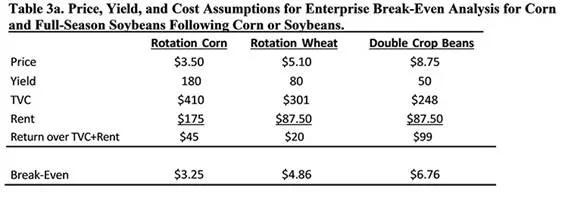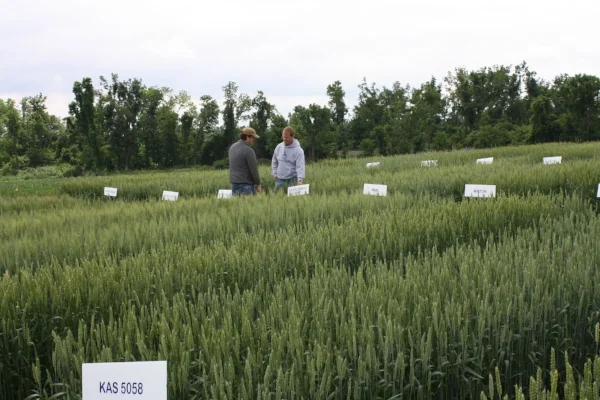Hybrid rye trials were established at Princeton and Lexington to compare seeding rates, growth regulators and fungicide applications. The growth regulator was supposed to reduce lodging, while the fungicide was supposed to reduce Fusairum head blight (head scab).
Read MoreThe overall objective of the research trials were to develop the best recommendations for managing Fusarium head blight (FHB; also known as scab) and the associated mycotoxin deoxynivalenol (DON; also known as vomitoxin) with foliar fungicides. The specific objective of each trial differed, and details and results of these trials are provided below.
Read MoreThe U.S. Department of Agriculture’s National Agricultural Statistics Service (NASS) released its Small Grains Summary Report today from the Small Grains Production Survey conducted earlier this month.
Read MoreCompared to last year there is a modest increase in wheat prices, and a significant decrease in soybean prices. These changes will make planting wheat more attractive relative to last year. The following analysis attempts to quantify the extent of the relative change in profitability for crops harvested in 2019.
Read MoreAs Kentucky grain producers look ahead to 2019, they may want to consider adding wheat seeding to their plans this fall. The combination of wheat followed by double-crop soybeans is appearing to be more profitable for the upcoming marketing year compared to a corn-soybean rotation, said Todd Davis, University of Kentucky agricultural economist.
Read MoreKy Small Grain Growers voted to fund the following research and grower education projects last month, for a total investment of $286,441, in the 2018-2019 growing season. That brings the total Kentucky small grain research funding to $3.3 Million over the past 27 years. New projects this year include several focused on Kentucky rye production due to increased interest from local distilleries.
Read MoreWith thinking about wheat planting has come the usual, and less usual, questions about fall soil fertility. This article is prompted by recent questions about one of the less usual topics, in-furrow starter fertilizer for wheat. What, how, why/when and why/when not? Photo from K-State.
Read MoreThe USDA reports reveal the potential for a bullish wheat market based on declining U.S. stocks as well as reduced stocks and production in major exporting countries.
Read MoreItalian or annual ryegrass (Lolium perenne L. ssp. multiflorum ) has been a major weed issue for Kentucky wheat growers for many years. The introduction of ALS-inhibiting herbicides that had selectivity on ryegrass brought about a great tool for con-trolling ryegrass in wheat post-emergence.
Read MoreOne of the most critical management decisions Kentucky wheat producers must make in late summer/early fall is choosing which wheat varieties to grow. Even though Kentucky’s climate is extremely variable from year to year, there are several must have traits: yield and test weight are always at the top of the list, but disease and lodging resistance are essential as well.
Read MoreThe University of Kentucky is holding a Late Season Field School on September 6, 2018. Sign in begins at 8:30 am and the workshop will run from 9:00 am to 4:00 pm.(CT).
Read MoreThe U.S. Department of Agriculture’s National Agricultural Statistics Service (NASS) is surveying Kentucky producers for its County Agricultural Production Survey (CAPS) small grains survey. The survey will collect information on total acres planted and harvested, and yield and production of small grains crops. CAPS will provide the data needed to estimate acreage and production of winter wheat in Kentucky.
Read MoreThe University of Kentucky Small Grain Variety Testing Program evaluates wheat and barley varieties that are commercially available or may soon be available to farmers. Annual variety performance testing provide farmers, seed producers, extension agents and consultants with current, unbiased information to help them select the varieties best adapted to their locality and individual requirements.
Read MoreLeadership of the Kentucky Small Grain Growers Association and Promotion Council attended the UK Wheat Field Day on May 8 to honor UK Wheat Breeder Dr. David Van Sanford for his many contributions to Kentucky's wheat industry.
Read MoreGrowing winter wheat and other cool season grains in Kentucky is not an easy task. And even though the current crop is still slowly progressing, my fellow growers and I are already looking at the challenges and opportunities of the next crop.
Read MoreThe center is a testament to the strong working relationship between UK specialists and Western Kentucky farmers with the idea coming from Logan County farmer Don Halcomb (Ky Small Grain Promotion Council Chairman) and Lloyd Murdock, UK extension soils professor emeritus.
Read MoreAfter a successful first year, we are pleased to announce the next series of trainings of the 2018 Wheat Field School at the University of Kentucky Research and Education Center (UKREC). This program is possible through the partnership and support of the Kentucky Small Grain Growers Association.
Read MoreThe November WASDE made minor changes to the 2017-18 wheat supply and demand projections, which is typical as there is little new production or demand information until the “final” estimates in January.
Read MoreChristian County is the leading wheat producing county in Kentucky for 2017, with production totaling 4,222,000 bushels, harvested from 53,000 acres. Wayne County had the highest average yield.
Read MoreAnnual UK Winter Wheat Meeting in Hopkinsville. CCA and Pesticide Credits approved.
Read More



















